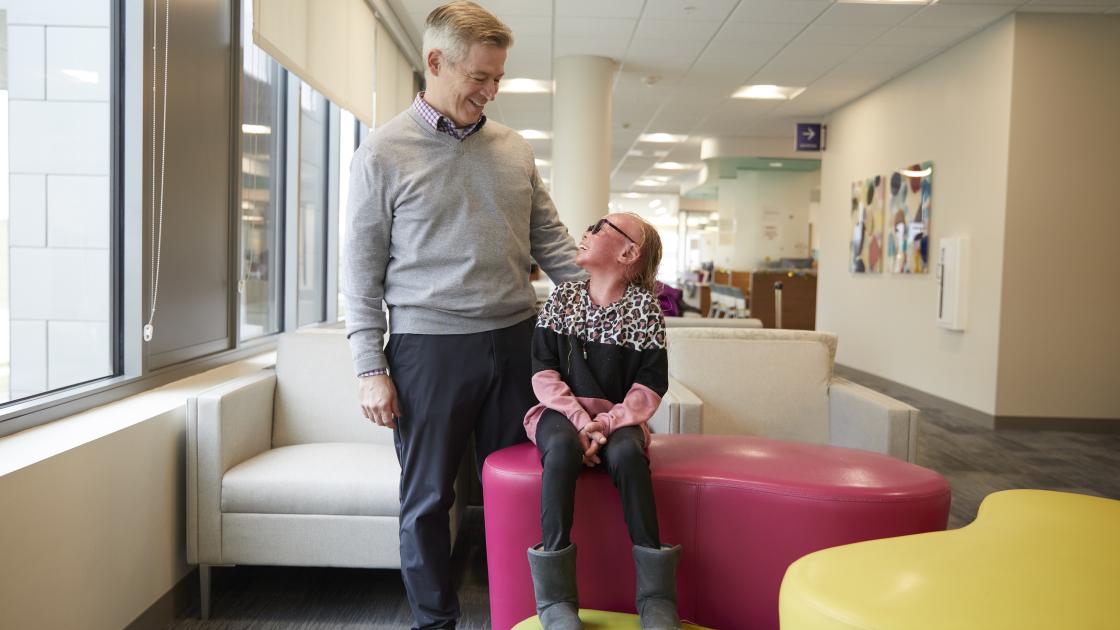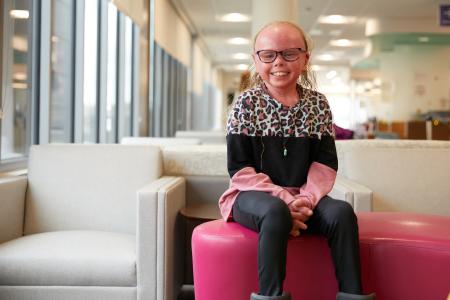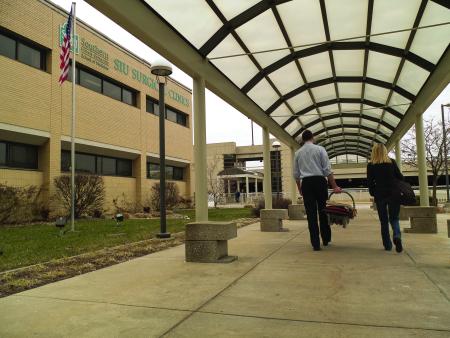
‘Baby Brenna’ is now a growing girl
Brenna Westlake was born in December 2011 with Harlequin Ichthyosis (HI), a very rare and sometimes fatal skin disease. Babies born with HI lack a protein that moves fats to the skin’s surface layer to create a strong barrier. They develop thick, scaly skin, have trouble maintaining a consistent body temperature and are susceptible to sepsis and dehydration.
Through a united effort, a team of SIU physicians and caregivers, led by neonatologist Dharmendra Nimavat, MD, and pediatric dermatologist Joseph Conlon, assisted Brenna’s parents, Courtney and Evan Westlake, to overcome the many challenges of her condition. Brenna was released from the HSHS St. John’s Hospital NICU 38 days after her birth. She went home to meet her older brother Connor and begin what would be an extraordinary life.
The story of Brenna’s early care was chronicled in the Spring 2012 issue of Aspects. Now 10 years later, we check in with her mother Courtney to see how the precocious fifth-grader and her family are doing.
BRENNA IS YOUR SECOND CHILD. EVERY CHILD’S BIRTH BRINGS A NEW DYNAMIC TO THE FAMILY, BUT HER GENETIC CONDITION TOOK IT TO A WHOLE OTHER LEVEL. HOW DID YOU, EVAN AND CONNOR ADJUST TO HER SPECIAL NEEDS AS AN INFANT AND TODDLER?
Brenna’s disorder has impacted our family in every possible way. It truly affects us every day. But it does not define us, and it does not define her. It was extremely challenging and stressful when she was young, and we were learning to care for her needs. But it became second-nature after a while, and it’s much easier today as she can communicate how she’s feeling and what she needs.

Raising Brenna has certainly changed so much of our perspective on parenting, our faith, beauty, and has really changed the way we live. But at the core, it has made our family much stronger and close-knit, too.
HOW WERE THE CARE TEAMS ABLE TO ASSIST YOU DURING BRENNA’S FORMATIVE YEARS? WERE THERE TIMES WHEN YOU WERE LEARNING THINGS TOGETHER?
Since Harlequin is so rare, learning to care for Brenna’s needs was definitely a team effort. We spoke with other families around the world to ask questions and share experiences, and our medical team conferred with other physicians who had more experience with ichthyosis. We have an incredible medical team who were willing to admit when they didn’t have an answer, so we could all try to find the answer together. They’ve also been open to trying new medicines or approaches, and they defer to us as the “experts” who are daily living with this condition.
WHAT WERE THE BIGGEST CHALLENGES?
Because the skin is the largest organ of the body, Harlequin ichthyosis affects many facets of Brenna’s health. One of the biggest challenges over the last 10 years has been temperature concerns. Brenna is unable to sweat and has trouble maintaining her body temperature. Most times we leave the house, we bring clothing layers like a jacket and hat as well as cooling products like a spray bottle and cooling vest that she wears to keep her core body temperature down. We have really pushed Brenna to recognize when she is overheating; now that she understands that and is responsible about what she needs to do to cool off, it has eased some of our concerns during summertime outdoor activities.
Another challenge has been balancing health concerns with living a fulfilling and productive life. The most impactful way our medical team, especially Dr. (Joseph) Conlon, helped us was to encourage us to try everything we would “typically” do as a family, even if we needed to get creative on how to accommodate Brenna. Because of that support, we’ve been able to experience activities with her that we never expected when she was first born, from summertime tubing on the lake to hiking in national parks to international travel.
WHAT IS BRENNA’S CURRENT HEALTH ROUTINE LIKE?
Brenna’s health routine is actually pretty unchanged from infancy; we’re just much more used to it! When I think about listing off everything we do on a daily basis, it sounds like a lot, but at this point, it doesn’t feel like a lot.
Our most important activity each day is her bath, so her body can soak up the moisture and we can rub off all of the extra skin that has built up over the last day. This lasts around 1.5 hours, but we all love that it’s also a built-in time to connect one-on-one with her. She still receives applications of Aquaphor lotion on her entire body around 4-5 times a day, and she will always require a lot of extra calories to make up for her excess skin production – thankfully she loves to eat!
Over the years, we have tried to foster independence and healthy decision-making as much as possible. Now that she’s 10, Brenna communicates with her doctors, we talk to her about medications and what they are used for, and we ask her what she thinks she needs when her skin is itchy or uncomfortable, so that she can take ownership over her skincare as she gets older.

CAN YOU SHARE A STORY ABOUT SOMETHING THAT HAS SURPRISED YOU RECENTLY, WHEN YOU THOUGHT YOU WERE ‘BEYOND SURPRISING’?
Evan: I always thought that Brenna wouldn't be able to play team sports due to her physical limitations. In fall 2021, she decided to join a rec soccer team. She has competed for eight months to the best of her ability and truly enjoyed every game with her teammates. At the game this week, she scored a goal. We are proud to see her participate in something unexpected and far outside of her comfort zone.
Courtney: This is a more negative approach to this question, but I don’t think I will ever stop being surprised at how blatantly rude and unkind some people can be in regards to the appearance of Brenna’s skin – both adults and children. I’m grateful that God has filled her heart with His love and purpose so that she is confident in how she was created and often able to laugh off people’s pointing and disrespectful comments.
COURTNEY, YOU HAVE CHANNELED SOME OF YOUR EXPERIENCES AS A MOM AND WOMAN OF FAITH INTO YOUR WRITING, IN A BLOG AND IN THE BOOK “A DIFFERENT BEAUTIFUL.” WHAT THERAPEUTIC AND EDUCATIONAL VALUES AROSE FROM IT?
Personally, writing about our experiences – in my book – helped me to process what I was feeling and what we were going through. It also connected me to parents around the world who could relate to raising a child with special needs, so life didn’t feel so overwhelming or isolating in those early days. But even better, sharing helped to educate others about ichthyosis. I heard from a woman who ended up marrying her husband (affected by a different type of ichthyosis) after she read about Brenna. We became close with another family who chose to adopt two children with ichthyosis after they read about what Brenna’s daily care entailed and felt encouraged they could assume those responsibilities. We know God was working within our story to connect us to families like those, just as He has worked through so many others to help us over the years.



